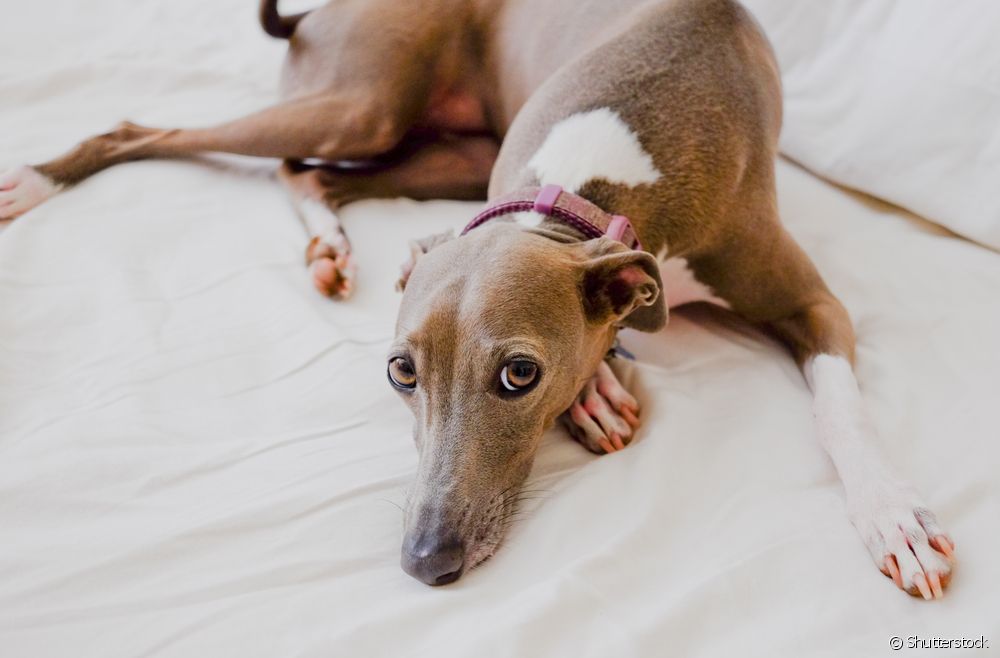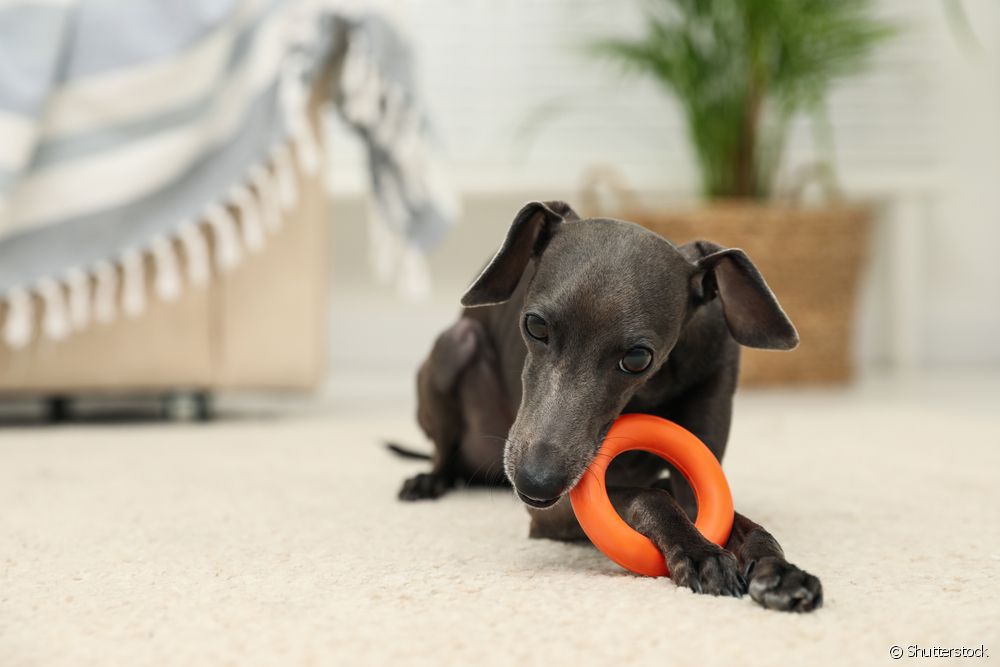Italian Greyhound: see a guide with all the characteristics of the dog breed

Table of contents
The Italian Greyhound is part of the Greyhound group of dogs, which includes other breeds such as the Greyhound (or English Greyhound, which is known as the fastest dog in the world ), the Spanish Greyhound and the Saluki. These are dogs that, although they share some physical similarities, also have particularities that set them apart. The Italian Greyhound is an athletic but small-sized dog. He hasa calm and loving personality, making them a great companion dog. At the same time, it's also good to keep an eye on their energy expenditure.
Although it is not one of the most popular breeds around here, the Italian Greyhound has everything to please many families. To learn more about this dog breed, see a guide with everything you need to know about the Italian Greyhound: value, care, characteristics and other curiosities.
Italian Greyhound: what is the origin of the breed?
Also known as the Little Italian Lebrel, the Italian Greyhound - or simply Greyhound - is a dog with a very ancient origin. Although it carries the name "Italian", the breed is believed to be a direct descendant of dogs that appeared in Ancient Egypt centuries ago. According to some records, dogs very similar to the Greyhound were found mummified in the tombs of the pharaohs.
Some time later, around the beginning of the 5th century, the breed arrived in Italy and began to develop in the way we know it today, becoming very popular among the country's nobility. It is estimated that the period of greatest development of the Italian Greyhound was during the Renaissance, so that the real popularity of the breed happened between XVI and XVII. Despite being old, the official recognition of theIt was not until 1886 by the American Kennel Club.
The Italian Greyhound's physical size favors racing
The Italian Greyhound is the smallest of the Greyhounds. It is a small dog that measures between 32 and 38 centimetres, and can weigh between 3.5 and 5 kg. Still, the breed carries the same physical characteristics of other dogs in the group, such as an athletic body, long and thin legs, a narrow head and an elongated muzzle. Its body shape, which is a little more curved, allows the Italian Greyhound to reachlong distances and can run up to 40 km/h.
The coat of the Italian Greyhound is very short, fine and silky, without the presence of bangs. Still on the hair of the Italian Greyhound, colors are diverse. It is possible to find the dog all black, gray, yellow, fawn and red. Variations of these shades are also accepted. White is only allowed if it is in the form of spots on the paws and chest.

The Italian Greyhound has a friendly personality, typical of a companion dog
- Coexistence
The Italian Greyhound dog is charming! The dog breed is very loving and loves to be close to the family. He is a great companion for those who spend more time at home, for example. This is because this puppy is very attached and does not like to spend long hours alone, requiring good doses of attention from the guardian. And by the way, a curiosity is that the Italian Greyhound tends to get attached...more to one member of the family - in general, it is the one who stays with him the longest. It does not mean that the Italian Greyhound does not like the other members, but he chooses a preferred guardian.
The breed's energy level is moderate. The breed is fast and agile, so it's common to find the dog running around at random times (even as if it were some sort of zoomies). This is even more common especially if it doesn't get the right stimuli. However, in general, low-intensity physical activities - such as apartment dog play and dog play - are a good idea.walks - already leave the animal well satisfied.
- Socialization
The Italian Greyhound is far from being a territorial or possessive dog. It is not jealous of its owners and is not aggressive, but it may bark to warn strangers that they are approaching, although it is not a good guard dog. The ideal is to socialize the animal from puppyhood to avoid such behaviors, making it more receptive to strangers. The Italian Greyhound also tends to get along wellwith children and other animals, provided it has been socialized in infancy.
- Training
Just like other puppies, the Italian Greyhound is quite intelligent! He is quite willing to learn, but he needs positive reinforcement to get interested in dog training. To hold the puppy's attention, it is good to have the help of treats, praise and affection. It is also important to have persistence and patience in the process, as this is a breed that requires several repetitions untilget the hang of it.
5 curiosities about the Italian Greyhound dog
1) A famous Brazilian personality who has an Italian Greyhound is Anitta. The singer's dog is called Plínio and has a legion of fans on the internet.
2) Besides Anitta, another well-known figure who is a fan of Greyhounds is Kylie Jenner. The American influencer has three dogs of the breed: Norman, Bambi and Kevin.
3) The Italian Greyhound was depicted in numerous artistic paintings during the Renaissance period. Giotto Carpaccio, David Bosch and Giovanni Tiepolo are some painters who have depicted the breed in their paintings.
4) Italian Greyhound, Whippet, Greyhound, Saluki and Spanish Greyhound are part of a select group of dogs, which are the Greyhounds.
5) For those looking for names for Greyhound puppies, some ideas are: Bolt, Comet, Spark, Lady, Skinny, Stick and Stella.
Italian Greyhound puppy: how to care for and what to expect from the puppy?
The Greyhound is a dog that does not give much work, and it is possible to notice this from puppyhood. This is a dog that will have moments marked by curiosity and adventures, but also likes to spend a good part of the time enjoying family programs. If he has some toys at his disposal, it is already possible to satisfy the puppy's energy needs even when he is a puppy.
Walks can also be included in the routine and are great for starting the pet's socialization process. However, the recommendation is that this should only be done after the Italian Greyhound puppy has had all the mandatory puppy vaccinations.
The adaptation of the house is an important step when adopting an Italian Greyhound. The puppy needs a space with a bed to sleep, hygienic mats to do his needs, drinking fountain, feeding trough and some toys. It is worth remembering that when we talk about feeding a puppy, the ideal is that breastfeeding is the main source of nutrition in the first two months. Then, thepuppy food should be implemented.

Day-to-day care of the Italian Greyhound
- Bath The owner can bathe the Italian Greyhound at least once a month. The dog shampoo and other hygiene products must be suitable for pets.
- Brushing : because they have very short hair, it is not necessary to brush them often. Once a week is enough to remove the dead coat.
- Nails You can't leave the animal's claws too long, or it may bother him when walking, so it's good to cut at least once or twice a month, according to each dog's needs.
- Teeth It is good to brush your dog's teeth regularly to avoid tartar, cavities and other unpleasant problems. The ideal brushing interval is every two days.
- Ears Check your Greyhound's ears weekly to make sure everything is in order. When necessary, clean the area with specific products.
- Cold The Italian Greyhound can suffer a lot from low temperatures, so in winter, be sure to invest in a doggy outfit and accessories to keep him warm.
What you need to know about the health of the Italian Greyhound
The Italian Greyhound has a more delicate health than other breeds and can develop a series of problems of genetic origin. Among them, we can highlight: hypothyroidism in dogs, alopecia, allergies and eye diseases (such as cataracts and glaucoma). In addition, because it has very thin legs, it is also common for the Little Greyhound to suffer from fractures, twists and dislocation of bones, especially those of the paw.
To avoid any surprises, the ideal is that the dog goes through periodic veterinary consultations. It is also important to take special care of the pet's joints and skin, which are naturally more fragile regions. Another important point is not to delay the dog's vaccinations and keep the dewormers and anti-parasitic drugs always up to date to keep the Italian Greyhound protected against diseases.
Galguinho Italiano: price can be up to R$ 4 thousand
Thinking of opening the doors to the Italian Greyhound? The value of the dog is not very expensive: puppies can be found for prices between R $ 2,000 and R $ 4,000. Some factors that influence this variation are the sex of the pet, hair colors and genetic lineage. If it is a dog descended from champions, for example, the price of the Italian Greyhound is more expensive. Female animals also tend to be more expensive.have a higher value.
See_also: Cat grooming: is it allowed to trim your kitty's hair?By the way, it is very important to pay attention to the price: Italian Greyhound is not usually sold for prices much below that. If you find a "promotion", be suspicious. Another important point is to choose a dog kennel that is reliable and committed to the welfare of animals. Do some research, look for references and if you can visit the place a few times before making the purchase to make sure.that no animal is mistreated.
X-ray of the Italian Greyhound dog
Origin : Italy
Coat : short, thin and soft
Colors : black, gray, yellow, fawn and red
Personality : affectionate, docile, attached and playful
See_also: Cat skeleton: all about the feline skeletal systemHeight : 32 to 38 cm
Weight : 3.5 to 5 kg
Life expectancy : 12 to 15 years

